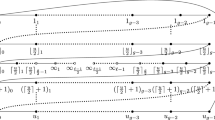Abstract
Coupled switched capacitance causes crosstalk in ultra deep submicron/nanometer VLSI fabrication, which leads to power dissipation, delay faults, and logical malfunctions. We present the first memoryless transition bus-encoding technique for power minimization, error-correction, and elimination of crosstalk simultaneously. To accomplish this, we generalize balanced sampling plans avoiding adjacent units, which are widely used in the statistical design of experiments. Optimal or asymptotically optimal constant weight codes eliminating each kind of crosstalk are constructed.

Similar content being viewed by others
References
Bertozzi D., Benini L., de Micheli G.: Low power error resilient encoding for on-chip data buses. In: DATE’02: Proceedings of the Conference on Design. Automation and Test in Europe, pp. 102–109. IEEE Computer Society, Washington, DC (2002).
Bertozzi D. Benini L., Ricco B.: Energy-efficient and reliable low-swing signaling for on-chip buses based on redundant coding. In: ISCAS’02: Proceedings of the IEEE International Symposium on Circuits and Systems, vol. 1, pp. 93–96. IEEE Press, Piscataway, NJ (2002).
Chee Y.M., Colbourn C.J., Ling A.C.H.: Optimal memoryless encoding for low power off-chip data buses. In: ICCAD’06: Proceedings of the 2006 IEEE/ACM International Conference on Computer-Aided Design, pp. 369–374. ACM Press, New York (2006).
Colbourn C.J., Rosa A.: Quadratic leaves of maximal partial triple systems. Graphs Comb. 2(4), 317–337 (1986).
Colbourn C.J., Ling A.C.H.: A class of partial triple systems with applications in survey sampling. Commun. Stat. Theory Methods 27(4), 1009–1018 (1998).
Duan C., Tirumala A., Khatri S.P.: Analysis and avoidance of crosstalk in on-chip buses. In: Hot Interconnects’01: Proceedings of the 9th Annual Symposium on High-Performance Interconnects, pp. 133–138. IEEE, Piscataway (2001).
Dukes P.J., Ling A.C.H.: Existence of balanced sampling plans avoiding cyclic distances. Metrika 70, 131–140 (2009).
Favalli M., Metra C.: Bus crosstalk fault-detection capabilities of error-detecting codes for on-line testing. IEEE Trans. Very Large Scale Integr. Syst. 7, 392–396 (1999).
Hamming R.W.: Error detecting and error correcting codes. Bell Syst. Tech. J. 29(2), 147–160 (1950).
Hedayat A.S., Rao C.R., Stufken J.: Sampling plans excluding contiguous units. J. Stat. Plan. Inference 19(2), 159–170 (1988).
Ho R.: On-chip wires: Scaling and efficiency, Ph.D. dissertation, Department of Electrical Engineering, Stanford University, Palo Alto, CA (2003).
Khan Z., Arslan T., Erdogan A.T.: A dual low-power and crosstalk immune encoding scheme for system-on-chip buses. In: PATMOS’04: Proceedings of the 14th International Workshop on Power and Timing Modeling, Optimization and Simulation. Lecture Notes in Computer Science, vol. 3254, pp. 585–592. Springer, Berlin (2004).
Niskanen S., Östergård P.R.J.: Cliquer User’s Guide, Version 1.0, Communications Laboratory, Helsinki University of Technology, Espoo. Tech. Rep. T48, (2003).
Patel K.N., Markov I.L.: Error-correction and crosstalk avoidance in DSM busses. IEEE Trans. Very Large Scale Integr. Syst. 12(10), 1076–1080 (2004).
Ramprasad S., Shanbhag N.R., Hajj I.N.: A coding framework for low-power address and data busses. IEEE Trans. Very Large Scale Integr. (VLSI) Syst. 7, 212–221 (1999).
Rossi D., van Dijk E.S., Kleihorst R.P., Nieuwland A.K., Metra C.: Coding scheme for low energy consumption fault-tolerant bus. In: IOLTW’02: Proceedings of the Eighth IEEE International On-Line Testing Workshop, pp. 8–12. IEEE Computer Society, Washington, DC (2002).
Rossi D., Cavallotti S., Metra C.: Error correcting codes for crosstalk effect minimization. In: DFT’03: Proceedings of the 18th IEEE International Symposium on Defect and Fault-Tolerance in VLSI Systems, pp. 257–266. IEEE Computer Society, Washington, DC (2003).
Rossi D., van Dijk E.S., Kleihorst R.P., Nieuwland, A.K., Metra, C.: Power consumption of fault tolerant codes: the active elements. In IOLTW’03: Proceedings of the Ninth IEEE International On-line Testing Workshop, pp. 61–67. IEEE Computer Society, Washington, DC (2003).
Samala N.K., Radhakrishnan D., Izadi B.: A novel deep sub-micron bus coding for low energy. In: ESA’04: Proceedings of the International Conference on Embedded Systems and Applications, pp. 25–30. CSREA Press, Leuven (2004).
Shannon C.E.: A mathematical theory of communications, Bell Syst. Tech. J. 27(3), 379–423, 623–656 (1948).
Sotiriadis P.P., Chandrakasan A.: Bus energy minimization by transition pattern coding (TPC) in deep sub-micron technologies. In: ICCAD’00—Proceedings of the 2000 IEEE/ACM International Conference on Computer-Aided Design, pp. 322–327. IEEE, Piscataway, NJ (2000).
Stan M.R., Burleson W.P.: Bus-invert coding for low-power I/O. IEEE Trans. Very Large Scale Integr. Syst. 3(1), 49–58 (1995).
Stan M.R., Burleson W.P.: Coding a terminated bus for low power. In: Great Lakes Symposium VLSI, pp. 70–73, Buffalo, NY (1995).
Stinson D.R.: Hill-climbing algorithms for the construction of combinatorial designs. In: Algorithms in Combinatorial Design Theory. Annals of Discrete Mathematics, vol. 26, pp. 321–334. Elsevier, North-Holland (1985).
Stufken J.: Combinatorial and statistical aspects of sampling plans to avoid the selection of adjacent units. J. Comb. Inf. Syst. Sci. 18(1–2), 149–160 (1993).
Su C.L., Tsui C.Y., Despain A.M.: Saving power in the control path of embedded processors. IEEE Des. Comput. 11, 24–30 (1994).
Subrahmanya P., Manimegalai R., Kamakoti V., Mutyam M.: A bus encoding technique for power and cross-talk minimization. In: VLSI Design 2004: 17th International Conference on VLSI Design, pp. 443–448. IEEE Computer Society, Xi’an (2004).
Victor B., Keutzer K.: Bus encoding to prevent crosstalk delay. In: ICCAD’01—Proceedings of the 2001 IEEE/ACM International Conference on Computer-Aided Design, pp. 57–63. IEEE, Piscataway, NJ (2001).
Wright J.H., Stufken J.: New balanced sampling plans excluding adjacent units. J. Stat. Plan. Inference 138, 3326–3335 (2008).
Zhang J., Chang Y.X.: The spectrum of BSA\((v, 3, \lambda ; \alpha )\) with \(\alpha =2,3\). J. Comb. Des. 15, 61–76 (2007).
Author information
Authors and Affiliations
Corresponding author
Additional information
This is one of several papers published in Designs, Codes and Cryptography comprising the “Special Issue on Cryptography, Codes, Designs and Finite Fields: In Memory of Scott A. Vanstone”.
Rights and permissions
About this article
Cite this article
Chee, Y.M., Colbourn, C.J., Ling, A.C.H. et al. Optimal low-power coding for error correction and crosstalk avoidance in on-chip data buses. Des. Codes Cryptogr. 77, 479–491 (2015). https://doi.org/10.1007/s10623-015-0084-4
Received:
Revised:
Accepted:
Published:
Issue Date:
DOI: https://doi.org/10.1007/s10623-015-0084-4
Keywords
- Constant weight codes
- Packing sampling plan avoiding adjacent units
- Crosstalk avoidance
- Low power code
- Packing by triples
- Balanced sampling plan




